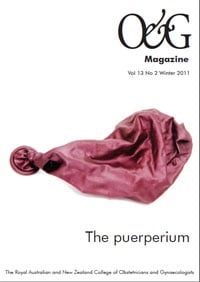Among the Indigenous population of Australia, and on a worldwide basis, infection during the puerperium causes significant morbidity and mortality.
Historically, the earliest reference to puerperal sepsis is reported in the work of Hippocrates in the fifth century BC. Infection of the genitourinary tract used to be, and still is, a major cause of morbidity and mortality in the postnatal period. Other causes are urinary tract infections (UTI), wound infection, mastitis and breast abscess. The major cause of maternal mortality is group A beta haemolytic streptococci (GAS). After the discovery of antibiotics, infections owing to GAS were brought under control. The recent CMACE report has highlighted the re-emergence of GAS infection in the UK.
In the puerperium the mother has a wound in the uterus (placental surface of the uterus). This is exposed to the vagina, which contains aerobic and anaerobic bacteria. In addition, some pregnant populations have anaemia or are nutritionally deprived, while some have chronic diseases such as diabetes, tuberculosis or HIV. These mothers, together with those on immunosuppresives, are prone to infection in the puerperium. Some mothers harbour Group B streptococcus (GBS) or GAS as a commensal while others may have Chlamydia, gonococcus or Gardnerella vaginalis. Events in and around labour, such as prolonged rupture of membrane, chorioamnionitis, repeated vaginal examinations, poor personal hygiene, catherisation of bladder, invasive fetal monitoring, instrumental deliveries, caesarean sections, episiotomies and manual removal of placenta lead to introduction of pathogens into uterus thus contributing to puerperal infections. Traumatic deliveries with devitalised tissue and blood clots in the presence of anaerobic environment provide an excellent medium for the anaerobic organisms to proliferate and cause infections.
Causes of puerperal infections
Endometritis
We now more commonly refer to puerperal fever as endometritis. This is usually a polymicrobial infection with aerobics and anaerobics. The organisms involved are group A beta-haemolytic streptococci, aerobic Gram-negative rods and anaerobes.
The patient usually presents with fever, lower abdominal pain, secondary postpartum haemorrhage and foul-smelling vaginal discharge. In severe infections, the patient may present with septicaemia. On examination, the patient will have a high temperature, rapid pulse and lower abdominal tenderness. On vaginal examination, there may be foul-smelling vaginal discharge and bleeding, subinvolution of uterus and cervical excitation. Vaginal swabs can be taken and sent for microbiology. Pelvic ultrasound may help differentiate products of conception from endometritis. White cell count will be elevated and blood culture may confirm the microbe responsible. The initial antibiotic regimen should be broad spectrum. One such regimen is IV cefuroxime 1.5g eight hourly plus IV metranidazole 500mg eight hourly until antibiotic sensitivity is known. Infection usually responds within 24–48 hours. If not, septic pelvic vein thrombosis needs to be considered. The complications of endometritis are parametritis, peritonitis, septic pelvic thrombophlebitis and pelvic abscess. Toxic shock syndrome, though not typically puerperal infection, has also been reported.
UTIs
UTIs are the commonest cause of puerperal infection. The predisposing factors are, apart from those mentioned above, history of previous UTIs, those with polycystic kidneys, congenital abnormalities of the renal tract, neuropathic bladder or urinary tract calculi, but most commonly they are idiopathic. It usually presents with dysuria, frequency, voiding disturbances, fever with chills and rigor and pain in the renal angle. On examination, patient will be febrile and tachycardic with renal angle tenderness and a urine analysis may show leucocytes, nitrates or protein. Urine for microscopy and culture should be done before starting IV cefuroxime 750 mg three times daily. Gentamicin should be considered in resistant organisms and those with an allergy to cephalosporins. Urinary microscopy and culture will help in the diagnosis. The commonest organism causing urosepsis is E coli, but others include enterococcus, klebsiella, proteus and staph epidermidis.
Mastitis and breast abscess
Mastitis usually presents with fever, breast pain and redness. Examination will confirm either mastitis or breast abscess. The commonest organisms involved are Staph aureus, Staph epidermidis Group A, B and F streptococci. In these cases, flucloxacillin needs to be started orally in the case of mild and intravenously in the case of severe infection with fever. In case of breast abscess, fluctuance will be elicited and an ultrasound scan needs to be done with a referral to surgeon for drainage.
Caesarean wound infections and perineal infections
Caesarean wound infection, where the uterine cavity is entered, differs from abdominal wound infection. Puerperal infection is more common in caesarean sections than in vaginal deliveries. Intra operative prophylactic antibiotics have helped to reduce the incidence of puerperal infections in caesarean sections. Caesarean wound infections have been reported with Staphylococcus aureus, MRSA, skin flora and with those organisms involved in endometritis.
Once infection is diagnosed, wound toilet and relevant antibiotics are the mainstay of treatment. Wound swab and blood culture help determine the microbe involved. In cases of simple wound infection, flucloxacillin is the drug of choice. Because caesarean wounds can be contaminated by vaginal flora, metronidazole can be added. If there is wound infection with cellulitis, benzylpenicillin IV and flucloxacillin IV should be started. In post-surgical septicaemia, IV cefuroxime and IV metronidazole are indicated. Wound dehiscence and necrotising fasciitis are complications. Infections of perineal wound are fortunately rare, but dehiscence and necrotising fasciitis are reported.
Other infections and incidental infections
If these more common sites of infection are excluded, one must be ever vigilant that there are no other sites of sepsis or serious viral infection, for example pneumonia (including Mendelssen’s syndrome), meningitis or bacterial endocarditis, hence the need for detailed history taking and examination and appropriate investigation. With international travel, malaria, influenza and H1N1 infections need to be considered.






Leave a Reply